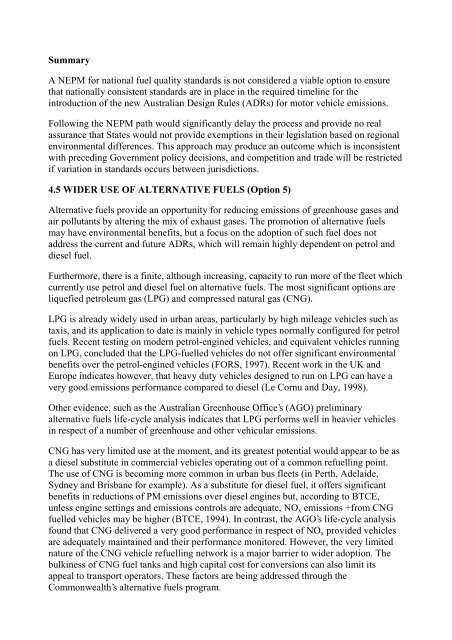National Fuel Quality Standards Regulation Impact Statement 1 ...
National Fuel Quality Standards Regulation Impact Statement 1 ...
National Fuel Quality Standards Regulation Impact Statement 1 ...
Create successful ePaper yourself
Turn your PDF publications into a flip-book with our unique Google optimized e-Paper software.
Summary<br />
A NEPM for national fuel quality standards is not considered a viable option to ensure<br />
that nationally consistent standards are in place in the required timeline for the<br />
introduction of the new Australian Design Rules (ADRs) for motor vehicle emissions.<br />
Following the NEPM path would significantly delay the process and provide no real<br />
assurance that States would not provide exemptions in their legislation based on regional<br />
environmental differences. This approach may produce an outcome which is inconsistent<br />
with preceding Government policy decisions, and competition and trade will be restricted<br />
if variation in standards occurs between jurisdictions.<br />
4.5 WIDER USE OF ALTERNATIVE FUELS (Option 5)<br />
Alternative fuels provide an opportunity for reducing emissions of greenhouse gases and<br />
air pollutants by altering the mix of exhaust gases. The promotion of alternative fuels<br />
may have environmental benefits, but a focus on the adoption of such fuel does not<br />
address the current and future ADRs, which will remain highly dependent on petrol and<br />
diesel fuel.<br />
Furthermore, there is a finite, although increasing, capacity to run more of the fleet which<br />
currently use petrol and diesel fuel on alternative fuels. The most significant options are<br />
liquefied petroleum gas (LPG) and compressed natural gas (CNG).<br />
LPG is already widely used in urban areas, particularly by high mileage vehicles such as<br />
taxis, and its application to date is mainly in vehicle types normally configured for petrol<br />
fuels. Recent testing on modern petrol-engined vehicles, and equivalent vehicles running<br />
on LPG, concluded that the LPG-fuelled vehicles do not offer significant environmental<br />
benefits over the petrol-engined vehicles (FORS, 1997). Recent work in the UK and<br />
Europe indicates however, that heavy duty vehicles designed to run on LPG can have a<br />
very good emissions performance compared to diesel (Le Cornu and Day, 1998).<br />
Other evidence, such as the Australian Greenhouse Office’s (AGO) preliminary<br />
alternative fuels life-cycle analysis indicates that LPG performs well in heavier vehicles<br />
in respect of a number of greenhouse and other vehicular emissions.<br />
CNG has very limited use at the moment, and its greatest potential would appear to be as<br />
a diesel substitute in commercial vehicles operating out of a common refuelling point.<br />
The use of CNG is becoming more common in urban bus fleets (in Perth, Adelaide,<br />
Sydney and Brisbane for example). As a substitute for diesel fuel, it offers significant<br />
benefits in reductions of PM emissions over diesel engines but, according to BTCE,<br />
unless engine settings and emissions controls are adequate, NOx emissions +from CNG<br />
fuelled vehicles may be higher (BTCE, 1994). In contrast, the AGO’s life-cycle analysis<br />
found that CNG delivered a very good performance in respect of NOx provided vehicles<br />
are adequately maintained and their performance monitored. However, the very limited<br />
nature of the CNG vehicle refuelling network is a major barrier to wider adoption. The<br />
bulkiness of CNG fuel tanks and high capital cost for conversions can also limit its<br />
appeal to transport operators. These factors are being addressed through the<br />
Commonwealth’s alternative fuels program.
















